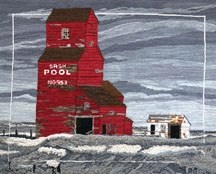Once an iconic common sight on Canada’s prairies, the grain elevator has almost vanished from the landscape.
The latest exhibit at the Okotoks Art Gallery (OAG) at the Station brings back memories of this symbol of western Canada’s rural roots. For the OAG’s first exhibit of 2012, the large gallery is hosting the exhibit, Grain Elevators: vanishing prairie landmark.
“We have on the prairies such a nostalgia for grain elevators, because it’s just such a vital part of our history,” she Rita Smith, curator of the exhibit, which is currently touring the prairie provinces.
The exhibit will be at the OAG from Jan. 6 to Feb. 5. An opening reception is scheduled for Jan. 13 at the gallery from 7 p.m. until 9 p.m.
It features hooked rug images of grain elevators and it’s sponsored by the Heritage Rug Hookers of Saskatchewan. The pieces were created by artists in six provinces including Newfoundland, New Brunswick, Manitoba, Saskatchewan, Alberta and B.C.
The exhibit is in its first year touring the prairies. It has already been across Saskatchewan, including a stint in the provincial legislature building, and it will be shown in locations across Alberta before moving on to Manitoba. She said there is also interest from galleries in other provinces.
Smith said the grain elevator is an iconic and beloved image, but the once common prairie landmark has been almost completely eliminated.
In Saskatchewan, she said there were 5,758 elevators in 1933 and now there are around 50. In her hometown of Borden, Saskatchewan, there used to be six elevators, but only one remains.
In Alberta the number of elevators peaked in 1934 at 1,755, but only 180 remained by 2005.
“It’s really a sad thing because the way our landscape is, they were so visible on the horizon,” she said. “They signaled that you were coming to a village and there would be people and hospitality and comfort and homes.”
While the images may bring back memories of earlier times, Smith said she hopes the exhibit also raises the profile of traditional rug hooking.
“There hasn’t been much exhibition in galleries of hooked rugs,” she said.
Rug hooking is a heritage art form stretching back to the era when people used whatever materials they had to create rugs for their floors.
She said the pieces are made on a base of either linen or burlap and are made from wool, sometimes hand-dyed by the artists themselves, or other fabrics like yarn pulled through the base using a hook.
It allows an artist to create different textures in their work.
“The sky is the limit, you can do anything,” said Smith.
She said it’s also a time consuming art form, with some artists using small pieces of fabric to create an image.
This is seen in the piece Winter Solitude, which shows a vibrant red, dilapidated elevator on a grey winter landscape. She said the artist used small fibres just millimeters wide to create the image of the elevator, while using more bushy yarn to illustrate tall grasses at its base.
Allan Boss, Okotoks’ cultural and historical services team leader, said it’s an ideal exhibit for the gallery to host given Okotoks’ rural roots and the elevators that once lined the rail tracks behind the gallery.
“They’re disappearing across the country so when we saw this proposal coming we though this was something that really would be appropriate to our location,” he said.
He said it’s an interesting and engaging exhibit using a unique art form.
“There’s a lot of texture and depth to the pieces,” he said.
A similar theme will be found this month in the OAG’s small gallery, which will host a members show, Gone but Not Forgotten.
The theme for the exhibit is inspired by its title and challenged artists to interpret it in their work.
The artists found unique ways to approach the subject in a variety of mediums. One unusual piece takes a unique interpretation of the theme by featuring a number of old, large toilets – not the eco-friendly, water-wise models of today.
“There are some really cool pieces that are going to be going in there,” said Boss.
The exhibit will also run from Jan. 6 to Feb. 5 and some of the pieces are for sale.




